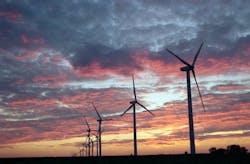New NREL Study Reveals How AI Can Benefit the Design and Deployment of Wind Plants in the US
According to an article in Nature Energy by researchers at the US Department of Energy’s National Renewable Energy Laboratory (NREL), the wind industry is expected to benefit from using artificial intelligence (AI) to design and deploy wind plants.
The researchers developed an AI-based surrogate model called the Wind Plant Graph Neural Network (WPGNN), which was trained on simulations of more than 250,000 randomly generated wind plant layouts under various atmospheric conditions, plant designs, and turbine operations. The simulation data was generated by another NREL-developed model, the FLOw Redirection and Induction in Steady State (FLORIS) tool.
Under the simulations, AI took the information to determine the optimal design of a wind plant and created calculations for the ideal plant layout and operation to achieve reduced land requirements and increased revenue.
The research focused on a wake steering strategy, which optimizes the amount of energy a plant produces by controlling the wake moving from an upstream turbine away from a downstream turbine. The use of AI helped the researchers determine the impacts of wake steering on three objectives: land use, cost, and revenue.
The WPGNN used by the NREL team represented wake interactions as a directed graph for investigating the optimal settings for both the turbine location and the nacelle's yaw across a nationwide wind energy portfolio.
The AI-guided scenario considered a nationwide deployment of 6,862 plant buildouts with a cumulative 721 GW of generated power to reduce 95% of carbon emissions from the energy sector by 2050.
The adoption of wake steering strategies is expected to reduce the land requirements for future wind plants by an average of 18% and by up to 60% in some instances. Nationally, the land savings will total about 13,000 sq km, equivalent to 28% of the wind energy footprint in the US.
“Previously, site-specific wake steering optimization studies were very difficult, but the graph representation in the WPGNN dramatically improved our ability to represent flexible layouts, changing wind directions, and perform gradient-based optimization,” wrote Ryan King, Senior Scientist at the NREL's Computational Science Center.
Installing more turbines in a smaller footprint is predicted to offer increased flexibility from a site-planning perspective and allow developers to study different economies of scale for larger projects.
The researchers also found that wake steering reduces the cost of energy for wind deployments. The AI allowed the researchers to reveal regional differences, enabling the strategy to be applied efficiently.
NREL’s high-performance computing resources helped researchers train the WPGNN, and DOE's Wind Energy Technologies Office funded the research.
About the Author
EnergyTech Staff
Rod Walton is senior editor for EnergyTech.com. He has spent 17 years covering the energy industry as a newspaper and trade journalist.
Walton formerly was energy writer and business editor at the Tulsa World. Later, he spent six years covering the electricity power sector for Pennwell and Clarion Events. He joined Endeavor and EnergyTech in November 2021.
He can be reached at [email protected].
EnergyTech is focused on the mission critical and large-scale energy users and their sustainability and resiliency goals. These include the commercial and industrial sectors, as well as the military, universities, data centers and microgrids.
Many large-scale energy users such as Fortune 500 companies, and mission-critical users such as military bases, universities, healthcare facilities, public safety and data centers, shifting their energy priorities to reach net-zero carbon goals within the coming decades. These include plans for renewable energy power purchase agreements, but also on-site resiliency projects such as microgrids, combined heat and power, rooftop solar, energy storage, digitalization and building efficiency upgrades.
